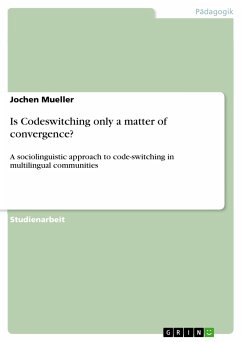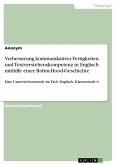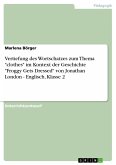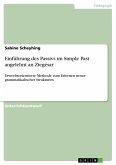Studienarbeit aus dem Jahr 2012 im Fachbereich Didaktik für das Fach Englisch - Pädagogik, Sprachwissenschaft, Note: 1,3, Universität zu Köln, Sprache: Deutsch, Abstract: Code- switching (CS) is a worldwide phenomenon and has been the norm in many different communities, but it was unnoticed and neglected by researchers for years. However, due to social changes, such as globalization and immigration, CS has surfaced in new places and thereby attracted attention. Nevertheless, those linguistics who researched into the occurrences of CS mostly commented on it negatively and categorized it as a form of interference and broken language. The perception of CS changed when Blom and Gumperz in 1972 focused on CS between dialects in a Norwegian fishing village and pointed at its social dimension and function. As a result, further studies of CS in various parts of the world were introduced and up until today it is a major research topic. Especially, the motivations for CS remain an interesting focus for those studies. Moreover, globalization and with this, the formation of multi-ethnical societies with a variety of different languages in a country is an on-going process and hence a late- breaking topic. Different sociolinguistic theories to explain this phenomenon have been developed. Two well-known approaches are Giles's Speech Accommodation Theory, nowadays revised as Communication Accommodation Theory (CAT) and Myers- Scotton's Markedness Model (MM). The first has its basis in psychology as it explains CS as a form of accommodation to converge to the addressee in order to become more alike and therefore narrow social distance. In contrast, the socio-psychological MM also takes macro-level perspectives into consideration and provides a generalization about how motivations for CS are interpreted. In this paper I will focus on CS in multilingual societies and examine, whether this process is only a matter of convergence as CAT claims. Further, I will match this theory with the MM as it is the leading model in terms of CS in multilingual communities. First, I am going to explain the basic theory of both approaches. After the establishment of a profound theoretical basis, I will introduce a study by Burt, who re-examined CAT's claim that every code- switch is motivated by convergence, respectively divergence. By this, the theoretical approaches will be put into practice and further examples from a multilingual family will be offered and closely analysed in terms of the motivations for the code- switches. Finally, an evaluation of the given analyses completes the paper and answers the question of the title.
Dieser Download kann aus rechtlichen Gründen nur mit Rechnungsadresse in A, B, BG, CY, CZ, D, DK, EW, E, FIN, F, GR, HR, H, IRL, I, LT, L, LR, M, NL, PL, P, R, S, SLO, SK ausgeliefert werden.









